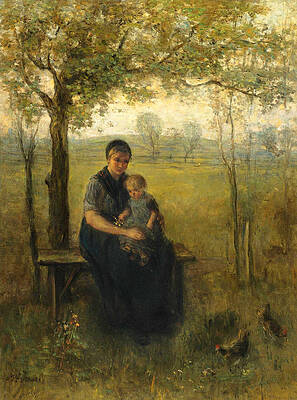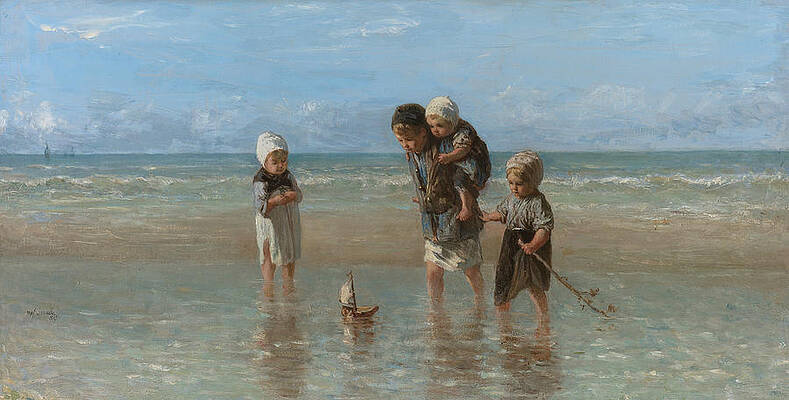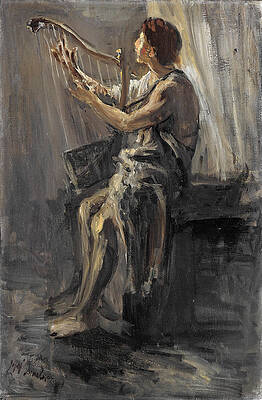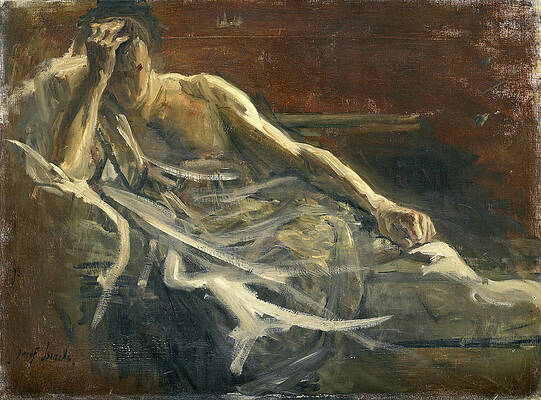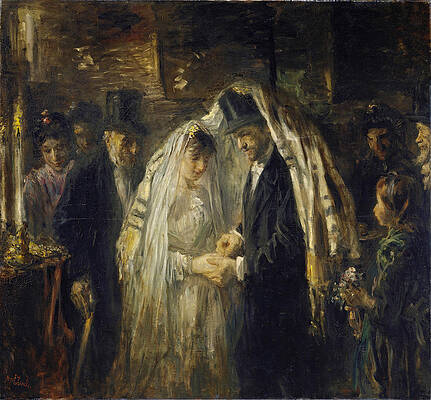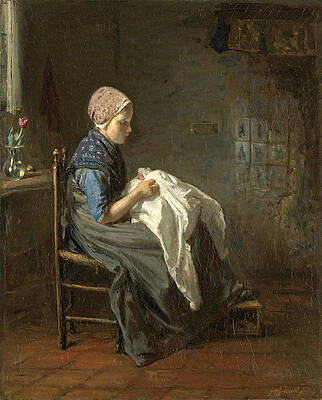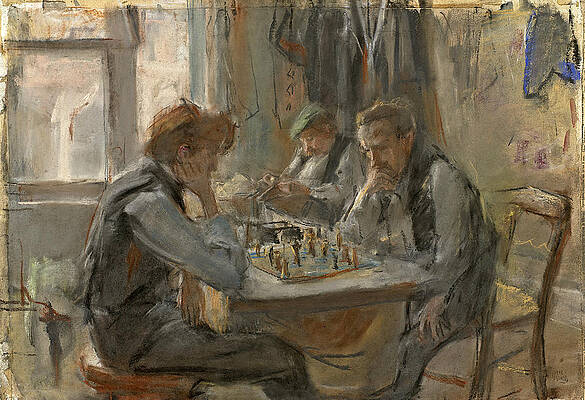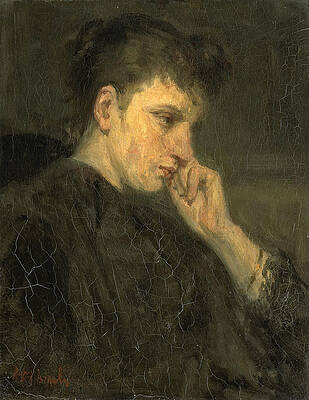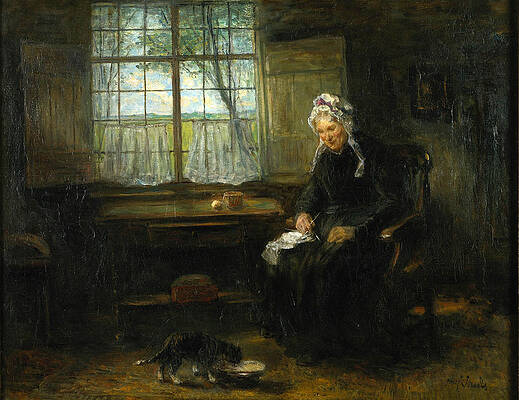Josef Israels, Jozef Israëls
Paintings
Dreams. Dolce far niente
David
Saul
Jewish Wedding
Neighborly Gossip
The Little Seamstress
Alone in the World
The Seamstress
The Chess Players
Melancholy
Knitting by the Window
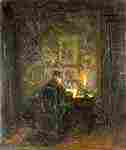
An Old Man writing by Candlelight
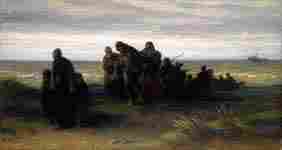
Fishermen carrying a Drowned Man
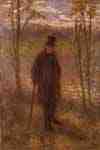
Drawings
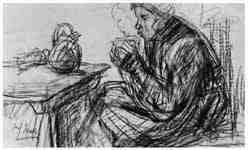
Coffee drinking womanJozef Israels
Jozef Israëls (27 January 1824 – 12 August 1911) was a Dutch painter, and "the most respected Dutch artist of the second half of the nineteenth century".[1]
Youth
He was born in Groningen, of Jewish parents. His father, Hartog Abraham Israëls, intended for him to be a businessman, and it was only after a determined struggle that he was allowed to enter on an artistic career. However, the attempts he made under the guidance of two second-rate painters in his native town Buys and van Wicheren while still working under his father as a stock-broker's clerk, led to his being sent to Amsterdam, where he became a pupil of Jan Kruseman and attended the drawing class at the academy. He then spent two years in Paris, working in Picot's studio, and returned to Amsterdam. There he remained till 1870, when he moved to The Hague for good,[2] where he became part of the Hague School of painters. He married Aleida Schaap and the couple had two children, a daughter Mathilde Anna Israëls and a son, Isaac Lazarus Israëls, born Amsterdam 3 Febr. 1865, who also became a fine art painter.
Sensibility
Israëls has often been compared to Jean-François Millet. As artists, even more than as painters in the strict sense of the word, they both, in fact, saw in the life of the poor and humble a motive for expressing with peculiar intensity their wide human sympathy; but Millet was the poet of placid rural life, while in almost all Israëls' pictures there is some piercing note of woe. Edmond Duranty said of them that they were painted with gloom and suffering.[2]
He began with historical and dramatic subjects in the romantic style of the day. By chance, after an illness, he went to recruit his strength at the fishing-town of Zandvoort near Haarlem, and there he was struck by the daily tragedy of life. Thenceforth he was possessed by a new vein of artistic expression, sincerely realistic, full of emotion and pity.[2]
Among his more important subsequent works are The Zandvoort Fisherman (in the Amsterdam gallery), The Silent House (which gained a gold medal at the Brussels Salon, 1858) and Village Poor (a prize at Manchester).[2]
In 1862 he achieved great success in London with his Shipwrecked, purchased by Mr Young, and The Cradle, two pictures that the Athenaeum magazine described as the most touching pictures of the exhibition.[2] A portrait of Jozef Israëls was painted by the Scottish painter George Paul Chalmers (1833–1878).
Later work
His later works include The Widower (in the Mesdag collection), When we grow Old and Alone in the World (Van Gogh Museum / Amsterdam gallery), An Interior (Dordrecht gallery), A Frugal Meal (Glasgow museum), Toilers of the Sea, Speechless Dialogue, Between the Fields and the Seashore, The Bric-a-brac Seller (which gained medals of honour at the great Paris Exhibition of 1900).
David Singing before Saul, one of his later works, seems to hint at a return on the part of the venerable artist to the Rembrandtesque note of his youth.[3] As a watercolour painter and etcher he produced a vast number of works, which, like his oil paintings, are full of deep feeling. They are generally treated in broad masses of light and shade, which give prominence to the principal subject without any neglect of detail. Israëls probably influenced many other painters and one them was the Scottish painter Robert McGregor (1847-1922).
There is a painting by Jozef Israëls in the Pushkin Museum of Fine Arts in Moscow. His son Isaac Israëls also was a painter.
See also
Hermann Struck
Notations
Wetering, Ernst van de: Rembrandt; The Painter at Work, page 133. University of California Press, 2000.
Chisholm 1911.
In his native land, Israëls was late in life viewed as the "reincarnation of Rembrandt. In 1893, the painter and art critic Jan Veth wrote: Rembrandt's great pathos seems to be resurrected in Jozef Israëls". Wetering, pages 133-4.
Attribution
This article incorporates text from a publication now in the public domain: Chisholm, Hugh, ed. (1911). "Israëls, Josef". Encyclopædia Britannica (11th ed.). Cambridge University Press. p. 885.
Sources
Jan Veth, Mannen of Betekenis: Jozef Israëls
Chesneau, Peintres français et étrangers
Philippe Zilcken, Peintres hollandais modernes (1893)
Dumas, Illustrated Biographies of Modern Artists (1882–1884)
J. de Meester, in Max Roose's Dutch Painters of the Nineteenth Century (1898)
Jozef Israëls, Spain: the Story of a Journey (1900).
----
Fine Art Prints | Greeting Cards | Phone Cases | Lifestyle | Face Masks | Men's , Women' Apparel | Home Decor | jigsaw puzzles | Notebooks | Tapestries | ...
----
Artist
A - B - C - D - E - F - G - H - I - J - K - L - M -
N - O - P - Q - R - S - T - U - V - W - X - Y - Z
Retrieved from "http://en.wikipedia.org/"
All text is available under the terms of the GNU Free Documentation License


